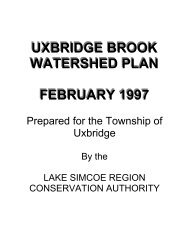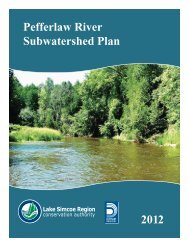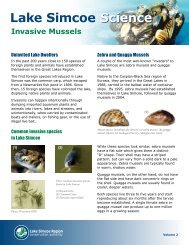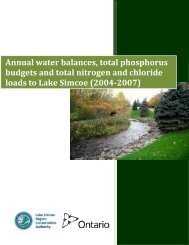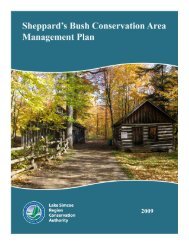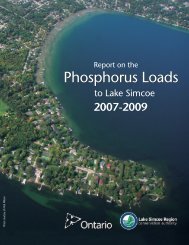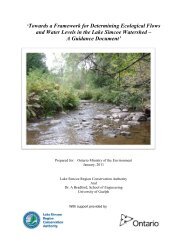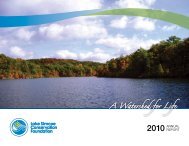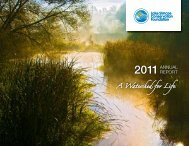Barrie Creeks, Lovers Creek, and Hewitt's Creek Subwatershed Plan
Barrie Creeks, Lovers Creek, and Hewitt's Creek Subwatershed Plan
Barrie Creeks, Lovers Creek, and Hewitt's Creek Subwatershed Plan
Create successful ePaper yourself
Turn your PDF publications into a flip-book with our unique Google optimized e-Paper software.
The <strong>Barrie</strong> <strong><strong>Creek</strong>s</strong>, <strong>Lovers</strong> <strong>Creek</strong> <strong>and</strong> Hewitt’s <strong>Creek</strong> <strong>Subwatershed</strong> <strong>Plan</strong><br />
Legislation <strong>and</strong> policy restrictions are the primary source of protection for aquatic natural<br />
heritage features in the Lake Simcoe watershed. However, some stresses are better suited to<br />
policy <strong>and</strong> regulation than others. For example, stressors such as climate change <strong>and</strong> invasive<br />
species are hard to regulate; however, activities related to the loss of habitat, or capture <strong>and</strong><br />
killing of fish are much easier to define <strong>and</strong> enforce.<br />
The Federal Fisheries Act defines fish habitat as “spawning grounds <strong>and</strong> nursery, rearing, food<br />
supply <strong>and</strong> migration areas on which fish depend directly or indirectly in order to carry out their<br />
life process”. Thus, fish habitat includes not only the water itself, but also the physical structure<br />
of watercourses, the vegetation along their banks, <strong>and</strong> factors related to the quality of water.<br />
As such, the Fisheries Act prohibits (unless authorized), the installation of dams or other<br />
structures within watercourses that obstruct the passage of fish, the modification of a natural<br />
watercourse (e.g. straightening, enclosing, or hardening of the shoreline), or the removal of<br />
vegetation along the shoreline.<br />
The Fisheries Act is further complemented by the Lake Simcoe Protection <strong>Plan</strong>, which (outside<br />
designated settlement areas) establishes restrictions to development or site alteration within<br />
100m of the Lake Simcoe shoreline (30m in already built-up areas, subject to a natural heritage<br />
evaluation) (policies 6.1 <strong>and</strong> 6.2), or within 30m of wetl<strong>and</strong>s <strong>and</strong> watercourses, with natural<br />
heritage evaluations necessary for development proposed within 120m of the feature (policies<br />
6.22 – 6.25). Exemptions to these policies are provided for existing uses, municipal<br />
infrastructure, <strong>and</strong> aggregate operations. These activities will be required to demonstrate that<br />
they maintain or improve fish habitat in the watercourse, wetl<strong>and</strong>, or riparian area.<br />
Within designated settlement areas, the Fisheries Act is complemented by municipal official<br />
plans. The City of <strong>Barrie</strong> Official <strong>Plan</strong> protects sensitive surface water features <strong>and</strong> their related<br />
hydrological functions, by prohibiting development in Provincially Significant wetl<strong>and</strong>s (<strong>and</strong> other<br />
wetl<strong>and</strong>s larger than 0.5 ha), <strong>and</strong> in valley <strong>and</strong> stream corridors, with riparian vegetation zones<br />
required as necessary to support resident cold water or warm water fish communities (policy<br />
4.7.2.5). The Town of Innisfil Official <strong>Plan</strong> protects aquatic habitats <strong>and</strong> ecosystem function by<br />
prohibiting development outright in Provincially Significant wetl<strong>and</strong>s, as well as prohibiting<br />
development within 30m of the Lake Simcoe shoreline <strong>and</strong> all watercourses <strong>and</strong> non-<br />
Provincially Significant wetl<strong>and</strong>s, unless the proponent can demonstrate no negative impacts<br />
will occur to the feature or its functions (policy 3.1.1).<br />
Beyond the protection of aquatic habitat features themselves, processes related to groundwater<br />
flow (including both recharge <strong>and</strong> discharge) are also protected by a suite of policy<br />
mechanisms. The Lake Simcoe Protection <strong>Plan</strong> requires LSRCA (in partnership with MOE <strong>and</strong><br />
MNR) to define <strong>and</strong> map ecologically significant groundwater recharge areas throughout the<br />
watershed. Ecologically significant groundwater recharge areas are those which are necessary<br />
to support coldwater fish habitat or wetl<strong>and</strong>s. Once identified, municipalities are required to<br />
incorporate these features into their official plans together with policies to protect, improve or<br />
restore the function of the recharge areas. Currently, LSRCA, in partnership with MNR <strong>and</strong><br />
MOE, is conducting a pilot study in the <strong>Barrie</strong> <strong><strong>Creek</strong>s</strong>, <strong>Lovers</strong> <strong>Creek</strong>, <strong>and</strong> Hewitt’s <strong>Creek</strong><br />
subwatershed areas to test the sensitivity of the different methodologies to identify these<br />
ecologically significant groundwater recharge areas.<br />
The City of <strong>Barrie</strong> Official <strong>Plan</strong> has such a policy framework in place, to be triggered upon the<br />
identification of ecologically significant groundwater recharge areas. These policies include<br />
controls over major development <strong>and</strong> expansion of designated settlement areas. Similarly, the<br />
Town of Innisfil Official <strong>Plan</strong> controls development in significant groundwater recharge areas, by<br />
requiring proponents to conduct detailed studies of the recharge area to ensure that the<br />
hydrological integrity of the feature is protected during development.<br />
Chapter 5: Aquatic Natural Heritage 253





